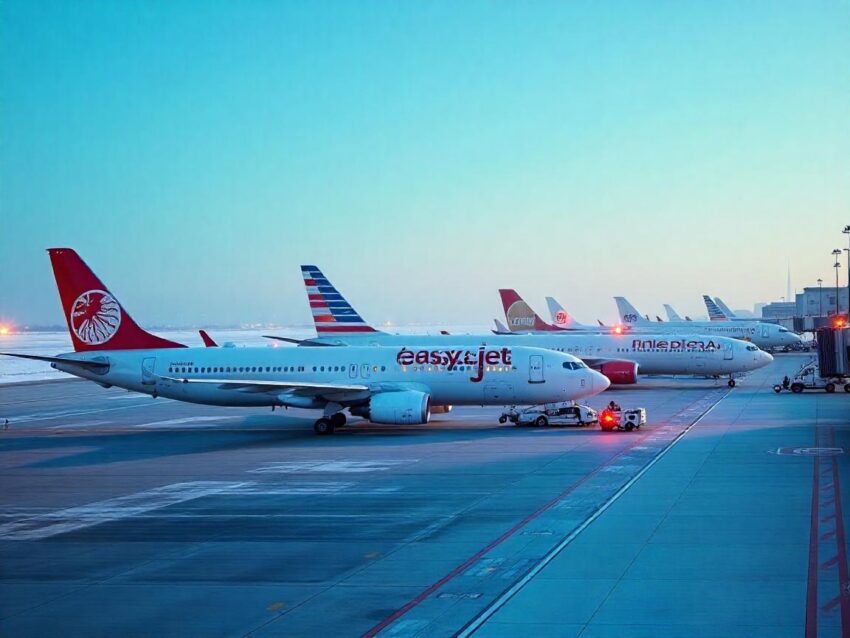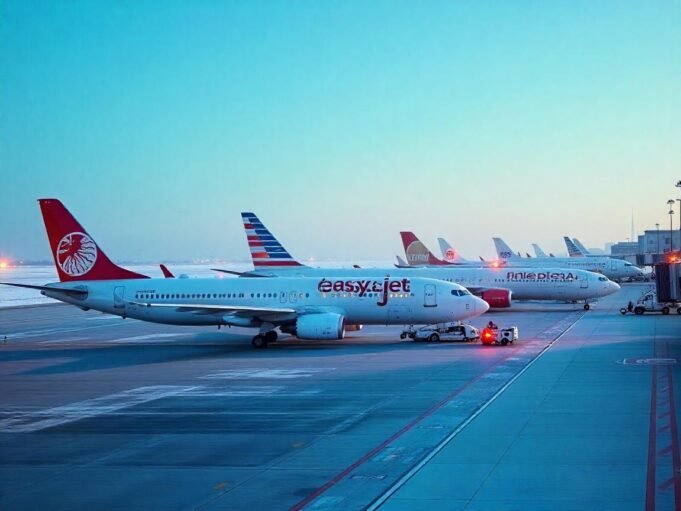Tuesday, July 8, 2025

As travelers look ahead to the colder months, airlines around the world are preparing for a busy winter season filled with new opportunities and fresh horizons. Canada-based WestJet is leading the charge, expanding its network with new routes designed to connect more people to sunshine, adventure, and cultural experiences.
But WestJet isn’t flying solo in this ambitious push. United, EasyJet, Norse Atlantic, and American Airlines are all rolling out new winter flights, tapping into growing traveler demand for diverse destinations and seamless journeys.
Together—though operating independently—these carriers are shaping a winter travel landscape defined by choice and excitement. From tropical escapes in Latin America to far-flung Asian cities and European getaways, the skies are opening up in new ways. For the travel industry and eager passengers alike, this winter promises fresh possibilities, competitive fares, and a renewed sense of wanderlust ready to take flight.
Record Winter Schedule Targets Sun-Seekers
WestJet is setting new records this winter, offering more sun destinations than at any time in its history. The airline plans to serve an impressive 62 warm-weather destinations across Latin America, the Caribbean, and the U.S.
Flights will depart from major Canadian hubs, including Toronto, Calgary, Vancouver, Montreal, Winnipeg, and Quebec City. All told, WestJet’s winter network will boast over 4,300 weekly departures to 106 destinations worldwide.
While total capacity remains stable, the carrier is increasing network frequency by 3% year-over-year—a move reflecting both sustained demand and strategic fleet optimization.
This is not just about adding flights; it’s about deepening connections between Canadian travelers and sunny escapes during the year’s chilliest months.
Five New International Destinations Signal Ambitious Growth
Leading WestJet’s winter push are five new international destinations, broadening its footprint across key leisure markets.
Starting this December, WestJet will introduce service to:
- Panama City, Panama (PTY): Four times weekly from Calgary
- Guadalajara, Mexico (GDL): Twice weekly from Calgary
- Tepic – Nayarit, Mexico (TPQ): Once weekly from Calgary
- Havana, Cuba (HAV): Twice weekly from Toronto
- Managua, Nicaragua (MGA): Once weekly from Montreal
These additions expand WestJet’s reach deeper into Central America and the Caribbean, offering travelers new options for culture, beaches, and adventure.
For destinations like Tepic—a gateway to Nayarit’s beaches and cultural heritage—the service could open new corridors for tourism and economic exchange.
Latin America and Caribbean See Capacity Surge
WestJet is leaning heavily into its Latin American and Caribbean markets, where demand for vacation travel remains strong.
The airline will increase seat capacity to these regions by 6% this winter. Popular destinations like Costa Rica, Mexico, and the Dominican Republic will see more flight options, helping Canadian travelers access tropical getaways with greater convenience and flexibility.
Beyond the sun and sand appeal, WestJet’s expansion signals confidence in the leisure sector’s resilience, even amid shifting economic headwinds and evolving consumer travel patterns.
Mexico City Now a Permanent Fixture
Adding to the momentum is Mexico City’s elevation to year-round status. Previously a seasonal route, WestJet’s service to the bustling Mexican capital will now continue uninterrupted through winter.
This decision reflects the strategic importance of Mexico City as a business and leisure hub. As trade, tourism, and cultural connections deepen between Canada and Mexico, sustained air connectivity is vital.
Mexico City’s inclusion underscores WestJet’s dual approach: serving leisure travelers while capturing business markets in key Latin American cities.
Seven New Seasonal Routes Cater to Winter Travelers
In addition to international expansions, WestJet is launching seven new seasonal routes this winter, each designed to meet Canadian travelers’ hunger for sunshine and variety.
The new seasonal flights include:
- Calgary – Cozumel (CZM): Once weekly
- Calgary – Puerto Plata (POP): Once weekly
- Vancouver – Liberia, Costa Rica (LIR): Once weekly
- Montreal – Samana, Dominican Republic (AZS): Twice weekly
- Quebec City – Montego Bay, Jamaica (MBJ): Once weekly
- Thunder Bay – Punta Cana, Dominican Republic (PUJ): Once weekly
- Winnipeg – Liberia, Costa Rica (LIR): Once weekly
These routes will operate between early December 2025 and mid-April 2026, providing flexibility for vacationers eager to escape winter’s chill.
Unified Cabin Experience Across the Fleet
WestJet’s expansion isn’t only about new destinations—it’s also transforming how travelers experience its fleet.
The airline has been systematically reconfiguring aircraft inherited from its Sunwing and Swoop acquisitions. By integrating these planes into a unified cabin layout, WestJet aims to ensure a consistent, reliable product for passengers, regardless of aircraft type.
Such changes reflect the airline’s strategic shift toward being a comprehensive leisure carrier with a standard service experience. For travelers, this means greater predictability and comfort, whether flying to Havana or heading south from Vancouver.
Strategic Vision Anchors Growth
WestJet’s winter growth reflects a calculated bet on leisure demand. The airline has pivoted decisively toward vacation travelers, a segment proving resilient amid economic fluctuations and shifting travel habits.
While business travel remains important, WestJet’s network choices make it clear that sun-seeking Canadians are the foundation of its winter strategy.
Furthermore, these network expansions serve not only Canadians looking to travel south but also international visitors heading to Canada, strengthening inbound tourism flows and local economies.
Broader Impact on Canada’s Travel Market
WestJet’s aggressive winter schedule will ripple across Canada’s travel industry. More flights mean more options for travelers, competitive fares, and opportunities for tour operators, hotels, and destination marketers to capture new business.
For Canadian airports, particularly hubs like Calgary and Toronto, these new routes will help maintain critical connectivity through winter, supporting jobs and regional economic activity.
Moreover, WestJet’s expansion into destinations like Nicaragua and Tepic may drive fresh interest among Canadian travelers seeking less crowded, more authentic travel experiences—a trend gaining traction post-pandemic.
WestJet Charts Confident Path into Winter
As winter approaches, WestJet is positioning itself to be the carrier of choice for Canadians dreaming of warmth, culture, and adventure. Its expanded network, new destinations, and commitment to modernizing its fleet reflect a company confident in its future and determined to lead in the leisure travel space.
For the travel industry, WestJet’s moves are both a barometer of consumer confidence and a signal that competition in Canada’s skies will remain fierce. The airline’s winter schedule offers a tantalizing array of possibilities for travelers and underscores how aviation remains at the heart of global tourism growth.
WestJet’s story this winter is about more than flights—it’s about connecting Canadians to the world and shaping how we travel in a new era of leisure aviation.
Even as summer skies remain busy, the aviation world is already turning its attention to winter—and this year, a wave of fresh international routes promises to reshape how travelers move across the globe. From the tropical beaches of Thailand to the historic cities of Europe and the sun-drenched coasts of Latin America, airlines are betting on diverse destinations to lure winter travelers.
Their strategies reflect the industry’s cautious optimism: while global travel demand continues to rebound, the market remains intensely competitive, with carriers vying for leisure travelers’ attention and wallets.
EasyJet Targets Winter Sun from Scotland
Low-cost carrier EasyJet is making headlines in the UK by adding a new winter sun route from Edinburgh to Málaga. Beginning October 28, 2025, this twice-weekly service will connect Scotland to Spain’s vibrant Costa del Sol.
Tickets start from as little as £41 one way, underscoring EasyJet’s commitment to affordability even as costs climb across the aviation sector. For Scottish travelers, the route promises easy escapes from grey winter skies to a region renowned for mild weather, cultural sites, and coastal resorts.
Málaga’s appeal extends beyond beaches: art museums, tapas culture, and nearby cities like Granada and Seville make it a compelling destination. EasyJet’s decision aligns with a broader trend among European carriers to boost connectivity to Southern Europe during the off-peak season, keeping planes full and costs managed.
Norse Atlantic Ventures into Asia
In the long-haul low-cost space, Norse Atlantic Airways is making an audacious move by launching new winter services to Thailand. Starting November 26, 2025, Norse will fly from Manchester to Bangkok once weekly, complementing new routes from Oslo and Stockholm.
This marks a significant shift for Norse, which had largely focused on transatlantic operations since its founding. Thailand represents both an opportunity and a challenge: while demand for Southeast Asian travel remains high, competition from established carriers like Thai Airways, Emirates, and Qatar Airways is fierce.
However, Norse’s budget-friendly fares could attract cost-conscious Europeans dreaming of Thai beaches and warm winter escapes. It’s a calculated risk that could pay dividends if the airline can maintain profitability on long-haul, low-yield routes.
IndiGo Enters Europe’s Big Leagues
Meanwhile, India’s largest low-cost carrier, IndiGo, is stepping onto the European stage in a big way. By winter 2025, IndiGo plans to launch new long-haul flights from India to London, Copenhagen, and Athens, expanding beyond its current European network that includes Amsterdam and Manchester.
This marks a pivotal moment for the airline. Traditionally focused on short-haul regional markets, IndiGo is leveraging India’s rising outbound travel demand and strong diaspora ties to Europe.
Flights to London and Copenhagen in particular suggest a strategy targeting both leisure and business segments, while Athens could appeal to Indians seeking Mediterranean holidays.
IndiGo’s expansion reflects confidence in India’s economic growth and travelers’ increasing appetite for long-haul journeys. Yet entering European markets also brings new complexities, including regulatory hurdles, slot competition at major airports, and the need for higher service standards on longer routes.
American Airlines Doubles Down on Florida
Across the Atlantic, American Airlines is sharpening its focus on domestic leisure demand, particularly connections to Florida. Beginning December 18, 2025, the airline will introduce daily services linking Boston with Orlando and LaGuardia with Jacksonville, alongside additional routes such as Boston to Key West.
These routes cater directly to Northeast U.S. travelers eager to escape winter cold for Florida’s mild climate and beaches. Post-pandemic travel patterns have shown that leisure demand remains strong, with families and retirees fueling steady traffic to Florida year-round.
American’s new services position it to compete fiercely with rivals like JetBlue, Delta, and Alaska Airlines, all of whom have increased capacity to the Sunshine State. It’s a clear sign that domestic leisure travel still represents a key battleground for U.S. carriers, even as international travel rebounds.
WestJet’s Ambitious Winter Growth
In Canada, WestJet is preparing for its biggest winter yet. The Calgary-based airline has announced five new international routes:
- Calgary – Panama City
- Calgary – Guadalajara
- Calgary – Tepic, Nayarit
- Toronto – Havana
- Montreal – Managua
In addition, WestJet will launch seven new seasonal sun routes, including services from Vancouver, Quebec City, Thunder Bay, and Winnipeg to destinations like Liberia, Montego Bay, and Punta Cana.
WestJet’s strategy signals a laser focus on leisure travelers. The airline is leaning into Canada’s tradition of seeking sun during the dark winter months, particularly in Latin America and the Caribbean.
Notably, the inclusion of Tepic and Managua suggests WestJet is exploring less saturated markets, seeking to differentiate itself from competitors serving more traditional resort destinations. These new flights could open untapped tourism corridors and support local economies eager for foreign visitors.
United Airlines Expands Globally
United Airlines, meanwhile, is spreading its wings further with eight new international routes planned for 2025. Highlights include service to Nuuk in Greenland, Ulaanbaatar in Mongolia, and Regina in Canada, expanding the airline’s global footprint into previously underserved markets.
These routes reflect United’s dual strategy: strengthening connectivity for niche destinations and capitalizing on unique traveler segments, such as adventure tourism and diaspora traffic.
Greenland and Mongolia, for instance, are attracting increasing interest from adventurous travelers seeking less conventional destinations. United’s decision to invest in these routes suggests confidence in consumers’ growing desire for unique experiences off the beaten path.
The Bigger Picture: A Market in Flux
Taken together, these new routes highlight the airline industry’s dynamic recovery as it heads into winter 2025/2026. Key trends emerge:
- Leisure is King: Airlines are placing significant bets on sun destinations and leisure travel, reflecting enduring demand for escapism amid lingering economic uncertainty.
- Low-Cost Long-Haul is Rising: Carriers like Norse and IndiGo are testing the limits of budget operations over longer distances, signaling fresh competition for traditional network carriers.
- Niche Destinations Gain Traction: Routes to Greenland, Mongolia, and Tepic show airlines are searching for unique markets to avoid saturation and differentiate their offerings.
- Domestic vs. Global Focus: While some airlines like American Airlines double down on domestic routes, others like United and IndiGo are pushing international boundaries.
Eyes on Winter Skies
As the aviation industry looks ahead to the colder months, it’s clear that airlines are navigating a transformed landscape. They’re expanding cautiously but creatively, introducing new routes that promise adventure, warmth, and connection.
For travelers, the news is overwhelmingly positive: more destinations, increased competition, and greater choice are all on the horizon.
Whether escaping the Scottish chill for Málaga’s sun, exploring Thailand on a budget flight from Manchester, or discovering Greenland’s frozen landscapes, this winter’s skies are set to be as diverse as ever.
Airlines are betting that travelers are ready to explore once more—and this winter, the world is theirs for the taking.
Tags: American Airlines, athens, Aviation industry, bangkok, Boston, Calgary, Canada, Copenhagen, easyJet, edinburgh, Guadalajara, Havana, Jacksonville, laguardia, london, Málaga, Managua, Manchester, Montreal, New airline routes, Norse Atlantic, Nuuk, Orlando, panama city, Regina, Tepic, Toronto, Ulaanbaatar, United











